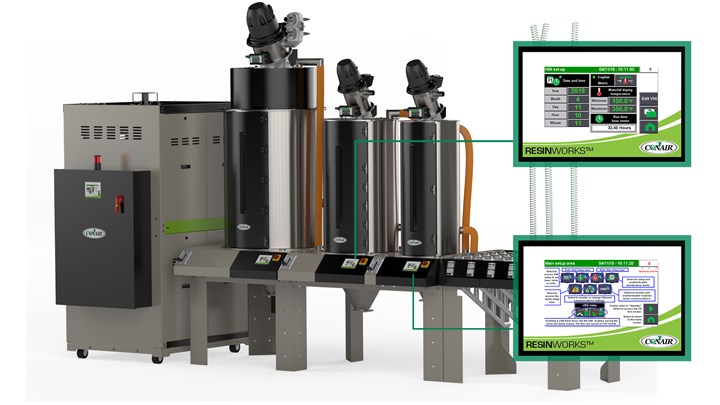Resin Drying: Central System Offers Individualized Hopper Monitoring, Trending and Control
New system from Conair allows implementation of advanced control features on a per-hopper basis, including on older Conair dryers, as well as some competitive units.
Conair’s ResinWorks central drying and pre-conditioning system provides the option to equip each drying hopper with its own 4-inch color touchscreen HMI, for independent operation, data monitoring and other advanced control features. The new HMIs, which are part of a control system upgrade across Conair’s dryer line, reportedly offer simpler, plain-text interaction with hopper features, settings, and help information.

Conair’s ResinWorks resin-handling and pre-conditioning system gives the option to add a 4-inch touchscreen control to each drying hopper.
With these HMIs, ResinWorks, which consist of multi-hopper units or sleds, can give users instant access to:
- Auto-start. Users can program automatic start-up for individual hoppers under specified drying conditions for pre-drying at a set day and time.
- Temperature control. Temps at each hopper can be set and monitored, enabling drying of a variety of different resins simultaneously.
- Drying Monitor. Conair’s Drying Monitor probes, which measure resin temperature at multiple points in each hopper, is supported, as is the “material ready” feature, which prevents material from being conveyed out of a ResinWorks hopper until properly drying per user instructions is confirmed.
- Temperature setback. Once desired drying conditions are reached, the HMI supports automatic temperature setback to reduce hopper temperature to a lower standby and prevent over-drying, while saving energy.
- Energy consumption and trending. Energy consumption trends in real time for each hopper can be tracked and used to calculate production costs.
Conair notes that users who pair the latest ResinWorks equipment with one of Conair’s new Carousel Plus dryers have the added option of controlling all hoppers centrally using the dryer control, or locally with the optional HMIs.
Related Content
-
How to Effectively Reduce Costs with Smart Auxiliaries Technology
As drying, blending and conveying technologies grow more sophisticated, they offer processors great opportunities to reduce cost through better energy efficiency, smaller equipment footprints, reduced scrap and quicker changeovers. Increased throughput and better utilization of primary processing equipment and manpower are the results.
-
Finding Efficiencies in How Components Work Together
Auxiliary systems are vital to the proper functioning of a plastic processing line, and they can be a source of major cost and efficiency improvements.
-
PiovanGroup Rebrands, with Mostly Minor Name Changes
For the most part, subsidiary company names will remain, with slight modifications meant to enhance the Group’s identity.




